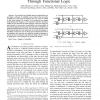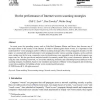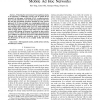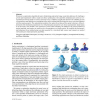109
Voted
ICRA
2010
IEEE
14 years 11 months ago
2010
IEEE
Abstract— We introduce a method for fast and accurate registration of multiple horizontal laser scans obtained by a mobile robot. The method is based on novel representation of t...
107
Voted
TCAD
1998
15 years 8 days ago
1998
Conventional scan design imposes considerable area and delay overhead by using larger scan
ip-
ops and additional scan wires without utilizing the functionality of the combinatio...
105
Voted
TCAD
1998
15 years 8 days ago
1998
—Conventional scan design imposes considerable area and delay overheads. To establish a scan chain in the test mode, multiplexers at the inputs of flip-flops and scan wires are...
114
Voted
TKDE
2008
15 years 16 days ago
2008
Often, it is required to identify anomalous windows over a spatial region that reflect unusual rate of occurrence of a specific event of interest. A spatial scan statistic-based ap...
127
click to vote
PE
2006
Springer
15 years 16 days ago
2006
Springer
In recent years, fast spreading worms, such as Code Red, Slammer, Blaster and Sasser, have become one of the major threats to the security of the Internet. In order to defend agai...
117
click to vote
JSAC
2006
15 years 17 days ago
2006
Protecting the network layer from malicious attacks is an important yet challenging security issue in mobile ad hoc networks. In this paper we describe SCAN, a unified networklayer...
138
Voted
CGF
2008
15 years 22 days ago
2008
We present a registration algorithm for pairs of deforming and partial range scans that addresses the challenges of non-rigid registration within a single non-linear optimization....
96
Voted
BMCBI
2010
15 years 22 days ago
2010
Background: Maximizing the utility of DNA microarray data requires optimization of data acquisition through selection of an appropriate scanner setting. To increase the amount of ...
148
Voted
DFT
2005
IEEE
15 years 2 months ago
2005
IEEE
A built-in self-test (BIST) scheme is presented which both reduces overhead for detecting random-pattern-resistant (r.p.r.) faults as well as reduces power consumption during test...
135
click to vote
ATS
2004
IEEE
15 years 4 months ago
2004
IEEE
Test data volume and scan power are two major concerns in SoC test. In this paper we present an alternative run-length coding method through scan chain reconfiguration to reduce b...




